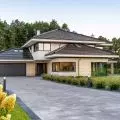Greenery in cities is being talked about more and more, the question is whether this discourse is doing any good? As part of our #CityMojeawNim series, we take a closer look at different areas of the city by talking to experts and female experts. We talk about urban greenery, what reigns in cities and how to improve the fate of greenery from an official and local government perspective with Dr. Joanna Rayss - a landscape architect.
Wiktor: What reigns in Poland - a shovel or an axe?
Joanna: The right and left hand of citizens. With the right they dig, and with the left they chop. And seriously, I think we abuse both of these weapons.
Victor: So shovels too?
Joanna: As much as possible, because with a shovel we can also harm nature. This is a very good question, because it makes you realize that we can harm greenery not only by cutting with an axe, but also by digging and destroying the root system, which is not actually protected in the Law on Nature Protection - it only talks about what is visible above the ground. Therefore, digging in the wrong way and in the wrong place is as harmful as actually cutting.
Various forms of greenery on the roof at Doki Living Gdansk.
© Author's Archive
Wiktor: I asked this because shoveling is associated with plantings and new greenery.
Joanna: To me, unfortunately, it is associated with digging in the wrong places and the immortal troughing for renovated and improved pavements. As for shoveling, however, for creating and developing greenery, a shovel is not always necessary either. Too little do we protect what is already growing on its own - that is, best conditions, and too often we make a show of shoveling by force .
Victor: Before we move on to the function and nature of urban greenery, I have to ask another question - has the word concretosis caught fire?
Joanna: This is a difficult question and I can't answer it unequivocally. However, I hope not. I'm sure it has become boring to the media, perhaps even to many of its popularizers. Above all, the media and not-so-professional journalists need new fodder every now and then. In this sense, maybe Concreteoza got bored and they would like to get a new keyword.
In conversations about space, I am able to ensure that concretosis is present, because the problem it describes is unfortunately still alive. It is a word that would arise to simplify reality and show the problem of excess impervious surfaces in our cities and the scarcity of nature, and in this sense it is a current problem.
Artificial wetlands on the Beaufort Estate in Gdansk.
© Author's Archive
Wiktor: What is the change in thinking about greenery?
Joanna: The key thing for me seems to be moving away from zero-one thinking. We have, either good greenery or bad greenery. Parks or wasteland, which is based on an aesthetic pattern and simplified functionality. For many years, aesthetics has been the basis for categorizing greenery.
Today, it is becoming essential to allow for the fact and imagination that greenery can be diverse in its form and the functions it serves in cities. If we look at functions other than aesthetic we will see that greenery can serve not only for active recreation, but also as a space for complex processes of metabolism and circulation of matter, improving the quality of our environment: water, air and soil, can be a sanctuary of biodiversity of all kinds of living organisms. Then we are ready to allow greenery of other forms and structure into our imagination.
We need not only beautiful flowers and trees, but also areas with shrubs, floral meadows, whether wet, ruderal or dry, biocenotic greenery such as blackthorn or hawthorn thickets, but also visually attractive perennial beds or biodiverse lawns. We are slowly allowing ecosystem services into our consciousness.
Wiktor: What do these services consist of?
Joanna: It is worth starting from the scientific side. Ecosystems are equally their animate part, - that is, the so-called biocenosis, which includes plants, animals, insects, bacteria, fungi, but also people; and inanimate - the so-called biotope: air, water, rocks or soil.
The links within a biocenosis (called trophic networks), as well as between a biocenosis and a biotope, are often invisible and unobvious, and they are in fact the key ones. What is most important for the existence of an ecosystem is not its physical structure itself, but precisely this flow of energy and matter within the ecosystem structure. This is how carbon, for example, circulates: taken from the atmosphere thanks to the ability of plants to photosynthesize, then built into the tissues and organs of so-called producers. Only then, in the form of proteins carbohydrates, et cetera, can it be eaten by herbivores and then predators, so that it is they who can build their organisms! After they die, it is decomposed by reductants and goes into soil storage. We should know and understand this simplified cycle of matter since kindergarten. Unfortunately, in the popular discussion about the role of trees in the city, it is not uncommon to end up with the claim that their primary value is oxygen production.
This "production" of oxygen is actually only a side effect in the process of photosynthesis. In addition, currently on our planet, we do not have an oxygen deficit problem! It's the issue of driving the carbon cycle that should be more important to us in terms of ecosystem functionality for both our nutrition and climate change mitigation reasons. However, I have the impression that there is more discussion about saving the world with electric cars, instead of a mature reflection about ecosystems and their actual role in the context of zero-carbon cities.
I dream of a serious discussion about cities as ecosystems, where our buildings, streets and technical infrastructure networks are a biotope and we are an equal, but not the only element of the ecosystem.
Carbon (element) flow in billions of tons per year
© Wikimedia Commons - Public Domain | author. Kevin Saff and FischX
Victor: That's essentially nature's principled goal.
Joanna: Yes, the problem is that it's not being talked about....
Victor: Maybe it's too difficult?
Joanna: Is it that difficult when we talk about it now? We talk about oxygen because we think we need it for breathing, and without breathing you can't live. However, without food also... oxygen we know how to stubbornly produce ourselves, worse with proteins, carbohydrates, fats et cetera. After all, we don't have an oxygen shortage crisis, so I don't understand why we keep saying that trees are needed because they produce that oxygen, It's a mistake.
Victor: Besides principled values like storing carbon, what other functions do ecosystems perform?
Joanna: It is worth noting that all functions are important, but the one related to the circulation of elements is the one we talk about the least. I recommend the movie The Martian and the board game Terraformation of Mars - there you can see very well that the primary services of ecosystems are the basis of survival on the planet, whether it's Mars or Earth :)
The ability of ecosystems to clean the air, water and soil is happily common knowledge. Of other important and not necessarily appreciated services, it is worth mentioning humidification of the air - greenery in this aspect actually helps eliminate dust - the cause of allergies and lung diseases. Dry urban air is usually the result of a lack of sufficient greenery.
Also important is biodiversity, which is necessary for life on our planet. It is what allows, over the long term, species to survive, and it is what underpins the self-regulation of ecosystems. In a situation of imbalance, such as new diseases, natural disasters et cetera, it is species richness and genetic diversity that allows survival through the diversity of forms and survival strategies of organisms. This gives life a chance to survive even the most difficult challenges and disasters.
Excessive sterilization and species simplification, which we persistently promote in our cities, feeds the spiral of pathological processes. Sterilization does not change the capacity of the environment, it only simplifies its species composition. That is to say, in a nutshell, if there is room for a certain number of insects per hundred square meters of lawn, reducing species diversity will lead to only flies, mosquitoes and ticks. These are pests that have lived with us for thousands of years, so they are highly specialized in surviving our various forms of exterminating them. Biodiversity will ensure that with the same number of insects, those we don't like will be much fewer, because the capacity of this lawn environment is unchanging.
Wet meadows on the Beaufort estate in Gdansk, Poland.
© Author's Archive
Victor: Let's talk about types of greenery in cities. I recently heard from one urban planning official that large parks are not built. I'm sorry that large parks are not being created. What is it like with them?
Joanna: I think your slip of the tongue is for good reason. In fact, parks are most often large construction and investment projects. And that's not how it should be - parks should be created. This is how the approach to the formation, creation and existence of greenery should differ from other elements: One builds objects, while parks should be created - this is a process, by definition, endless.
Creating the assumptions for the concept of the South Park in Gdansk, I just tried to show that it is possible to create large parks in a modern and ecosystemic way - Not by building but by transforming the land, changing the functionality and using the resource that has already grown. Very often such areas are categorized as so-called urban wastelands. This is a fatal term for areas with such rich ecosystem functionality. In fact, these are areas of biocenotic greenery, at various stages of naturalness and development of the process of natural succession.
assumptions outlined by Joanna Rayss
© Author's Archive
Victor: You can talk about natural use.
Joanna: Exactly! Every city has such areas on which it can build, creating parks to suit modern, diverse spaces. Yes, undoubtedly, we need historical or typically recreational parks. Within their area, it is worth creating biodiverse and biocenotic spaces, which will be a kind of vaccine of biodiversity and natural processes, in these often sterilized facilities.
South Park
© Author's Archive
Victor: And going back to the large scale of the parks? I understand that they can be created, but on the condition that they combine different functions.
Joanna: Yes. I think we need to redefine both the term park and the general classification of green spaces/landscaping facilities - to allow for the existence of fragments dedicated to nature, with a more diverse character. We also need this in order to impose a somewhat process-oriented, variable and multifunctional character of greenery and its ecosystem functionality should be a mandatory guideline. I'm afraid that mono-functional designations of urban greenery, such as historic park, cemetery or zoo, do not allow for the internal natural diversity of their structure and, consequently, functional diversity. Therefore, according to current knowledge, it is wrong and harmful.
design of a wild zone in a southern park
© Author's Archive
Victor: We started with large parks, now let's go down a level - what about small parks including pocket parks or squares? Can they combine several functions?
Joanna: Let's compare a city to a house - each of us, whether we live in a house or a small apartment always tries to designate basic functional zones in the house like kitchen, bedroom or bathroom. That house may be a thousand square meters, but it may as well be a thirty-square-meter studio, but always with a toilet, shower or bathtub, sleeping and cooking space.
Think similarly about green areas in cities - regardless of the size of the city and the size of the green area itself, the condition for its ecological functioning is to generate within its borders several basic zones of different ecological functionality. In accordance with this principle, for example, we divided the area of the aforementioned South Park in Gdansk into four zones, depending on their degree of natural maturity and, consequently, their degree of naturalness: the "wild" zone, the "succession" zone, the "orchard" zone of both domesticated and natural boles, and the "recreation" zone.
We then adjusted the functionality of typical recreational activities so that they do not conflict with natural processes. That is, the more nature, the less of us humans, and vice versa - where natural processes are present least without harm, we can afford our intensive presence.
At the two poles there is the extreme wilderness part and the extreme recreational part. I think we should always try to look for such at least two or three diverse zones.
Wet meadows on the Beaufort estate in Gdansk, Poland.
© Author's Archive
Wiktor: Is it possible to reconcile them?
Joanna: It is necessary, though not necessarily easy. It's certainly a big challenge for landscape architects, but challenges are there to be met. In small parks and squares it is certainly not possible to put all possible zones, sometimes four, only two, maybe three. It's a matter of balancing needs and possibilities.
Victor: To sum up, small parks and squares are necessary in cities, but they should have more than one function?
Joanna: Yes, it is imperative that we think of them as something alive. An ecosystem is a process that, by definition, after just a few weeks will not look like the day it was "put into use." Similarly, the care of park areas - we should design their maintenance in terms of variability and species replacement. Then we will also maximize their functionality in terms of the ecosystem services provided. The more zones we have, the more services we will squeeze out of them, and that's our living interest.
Victor: Going further down. Lower down is roadside greenery - that along roads, sidewalks and paths. Is it needed, how to take care of it and design it with traffic safety in mind?
Joanna: It's great that you ask this, in cities it's probably the most difficult topic. The most difficult, because ecosystems and their populations need connectivity for their proper functioning, development and survival. By definition, any system should be coherent and connected, and green spaces in a city should, by definition, be precisely a coherent urban ecosystem. Communication systems designed in the right way can become green corridors of sorts - this is what landscape ecology/urban ecology is all about. In addition, it's also potentially a tool that acts as a buffer to catch any roadside pollution. Roadside greenery can and even should mitigate any discomfort, it just needs to be properly designed and maintained.
Greenery can and should be an infrastructural element
© Author's Archive
Victor: So it doesn't have to be a sprawling lawn or a withering shrub just what ?
Joanna: It can be vegetation that is more resilient. You can combine the functions of roadside greenery with buffer and retention elements, using vegetation with a natural function of ecological filters in soils with increased retention capacity. In our climate there are quite a few plant communities that are excellent models for this type of planting. The only problem I see here is aesthetics - this type of vegetation does not always look the way the average city dweller wishes. This is not the type of "elegant" vegetation and certainly cannot be simplistic monocultures. However, I think it's worth lobbying for the aesthetics of nature, because it has great utility value for us humans and our cities.
By the way, it is paradoxical that we can put up with the ugliest advertisements, electrical boxes and unsightly sidewalk in our cities, but greenery and flowerbeds that do not suit our tastes become the biggest problem.
Victor: Maybe I should ask instead of a saw and shovel, a saw and mower?
Joanna: Why not? I dream in the age of popularity of the fitness industry the return of the scythe. There is nothing better for a health-conscious man or woman than taking a scythe in hand!
Victor: On the wave of popularity of "Peasants" it is not out of the question.
Joanna: Maybe on the wave of renaissance of Slavic traditions we could return to haying competitions :) And seriously I think we should promote work with a scythe.
Wiktor: In landscape architecture and its trends there are phenomena that break through marketing - these are micro-forests, flower meadows or rain gardens. However, isn't there some element of greenwashing in them, don't all these solutions contain this element?
Joanna: These elements in themselves do not contain greenwashing. For me, greenwashing is the use of a good phenomenon to build a "brand" or PR in a way in which the sum of the environmental benefits is much lower than the costs put into the activity itself and its popularization. Even of the best things we can make greenwashing. A flower meadow sown in a two-by-two-meter square, additionally composed only of non-native annual plant species, is such an example. An extensive flower meadow modeled after natural periodically flooded meadow communities sown in the depressions of the land to compensate for the hydrology of the investment is a fantastic use of ecosystem services and an excellent example of blue-green infrastructure.




















































